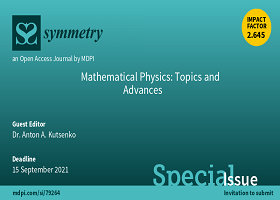Mathematical Physics: Topics and Advances
A special issue of Symmetry (ISSN 2073-8994). This special issue belongs to the section "Mathematics".
Deadline for manuscript submissions: closed (30 April 2022) | Viewed by 12181

Special Issue Editor
Special Issue Information
Dear Colleagues,
The concept of symmetry permeates all areas of science, and in fact, serves as the basis of any direction in scientific activity. Even in seemingly completely disordered and chaotic systems, the discovery of some regularities and symmetries is the greatest achievement. Most laws of nature are based on the observation of some sort of symmetry. Thus, symmetry is an absolutely interdisciplinary concept. However, the most expressive language for describing symmetry is mathematics. For example, algebras of operators acting on periodic lattices, or on fractal structures, are a powerful tool for revealing the symmetry properties of natural phenomena and physical processes. The present Special Issue is devoted to the application of various algebraic structures to problems of mechanics and physics. We are inviting authors working in such areas as:
- Spectral theory;
- Operator theory;
- Linear waves in heterogeneous structures;
- Non-linear waves, ocean waves;
- Homogenization theory;
- Representation theory.
Dr. Anton A. Kutsenko
Guest Editor
Manuscript Submission Information
Manuscripts should be submitted online at www.mdpi.com by registering and logging in to this website. Once you are registered, click here to go to the submission form. Manuscripts can be submitted until the deadline. All submissions that pass pre-check are peer-reviewed. Accepted papers will be published continuously in the journal (as soon as accepted) and will be listed together on the special issue website. Research articles, review articles as well as short communications are invited. For planned papers, a title and short abstract (about 100 words) can be sent to the Editorial Office for announcement on this website.
Submitted manuscripts should not have been published previously, nor be under consideration for publication elsewhere (except conference proceedings papers). All manuscripts are thoroughly refereed through a single-blind peer-review process. A guide for authors and other relevant information for submission of manuscripts is available on the Instructions for Authors page. Symmetry is an international peer-reviewed open access monthly journal published by MDPI.
Please visit the Instructions for Authors page before submitting a manuscript. The Article Processing Charge (APC) for publication in this open access journal is 2400 CHF (Swiss Francs). Submitted papers should be well formatted and use good English. Authors may use MDPI's English editing service prior to publication or during author revisions.
Keywords
- operators
- algebras
- phononic crystals
- waves
- fractals
- Schrödinger equation
- spectrum
- perturbation theory
Benefits of Publishing in a Special Issue
- Ease of navigation: Grouping papers by topic helps scholars navigate broad scope journals more efficiently.
- Greater discoverability: Special Issues support the reach and impact of scientific research. Articles in Special Issues are more discoverable and cited more frequently.
- Expansion of research network: Special Issues facilitate connections among authors, fostering scientific collaborations.
- External promotion: Articles in Special Issues are often promoted through the journal's social media, increasing their visibility.
- e-Book format: Special Issues with more than 10 articles can be published as dedicated e-books, ensuring wide and rapid dissemination.
Further information on MDPI's Special Issue polices can be found here.





